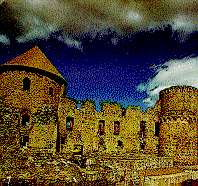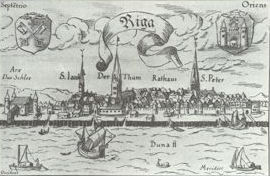
Battles and Campaigns
|
|
Swedish Polish War 1600 to 1609 1601 Spring Summer Campaign (3) The Swedish fleet landed new forces forces at Dynemunt on 19th June. Radziwill sent Dorohostajski on 28th June, who dislodged the Swedes in the middle of July. Meanwhile the poor relationship between the hetmans worsened and Chodkiewicz, with 700 comrades plus retainers, left Radziwill with 2,000 men.
Gyllenhjelm stood in a fortified camp between Burtnecki and Rujen and even though reinforcements arrived, among them Chodkiewicz, Radziwill decided not to risk an attack and moved to Ronneburg on 23rd July. Ronneburg was a harder nut to crack than Radziwill anticipated and by August illness and desertions had reduced his army to some fourteen hundred men.
Back in Sweden Duke Charles was already raising new forces. He was concerned at the recent success of the enemy and aimed to gain some advantage before the arrival of the bulk of the Royal forces. This time his target was Riga and he chose the coastal road as the shortest route from Parnawa. Duke Charles managed to concentrate a land force of over 12,000 men with 20 cannon and led by Count John Nassau - pupil, friend and associate of Maurice of Nassau, Prince of Orange and architect of the new Dutch infantry tactics. He arrived at Parnawa on 26th July. Without waiting for the arrival of all his forced, due to his concerns over the besieged Ronneburg, Duke Charles left Parnawa on 16th August. He marched along the coast to Salis where on around the 20th August he met up with Gyllenhjelm. This move threatened Radziwill's lines of communication and route of retreat to Riga. So on the 23rd of August Radziwill left for Kies and then moved towards Riga in order to link up with Farensbach's 2,000 men. These were the leading group of the Royal forces which had arrived on 21st August. The Polish-Lithuanian army was encumbered with 3,000 wagons and a sizable number of cannon and at Nitau on 31st August Count Nassau caught up with them. From there the Polish-Lithuanian retreat became a series of heavy rearguard actions and amongst some heavy losses were 300 wagons. On 2nd September Radziwill's forces reached Riga. The port had been blockaded by the Swedes from around June and Farensbach, with a few ships, successfully attacked the Swedish fleet on the Dzwina and forced it to retreat on 26th August to Dynemunt. |
|
||||||||||||||||||||||||||||||||||||||||||||||||||||||||||||||||||||||||||||||||
![]()
 Meanwhile
Gyllenhjelm retreated through Kies to Burtneck (Burtnieki) to the
north west of Wolmar. While Radziwill attempted to take advantage
of the victory by recapturing as much of Livonia as possible. He
divided his forces and took many castles in the south, such as Erlaa
and Pebalg. Radziwill himself left Kokenhausen on 6th July directing
his troops towards Gyllenhjelm through Kies, which capitulated on
the 14th.
Meanwhile
Gyllenhjelm retreated through Kies to Burtneck (Burtnieki) to the
north west of Wolmar. While Radziwill attempted to take advantage
of the victory by recapturing as much of Livonia as possible. He
divided his forces and took many castles in the south, such as Erlaa
and Pebalg. Radziwill himself left Kokenhausen on 6th July directing
his troops towards Gyllenhjelm through Kies, which capitulated on
the 14th. 






 Duke
Charles' army approached Riga on 6th September and in the region
of Nowy Mlyn (New Mill) the forces spread out. The town had strong
new fortifications and Farensbach raised fieldworks on the high
ground at Kubsberg in front of the town ramparts placing there 600
Scottish soldiers with 15 cannon. Without heavy artillery, the Swedes
attempted a surprise attack. On the 9th at two in the morning 4,000
infantry attacked the fortifications at Kubsberg and despite fierce
resistance captured it and almost penetrated the town. Farensbach
ejected them with his counter attack. With the approach of the main
Royal forces the Swedes retreated into their occupied towns and
castles.
Duke
Charles' army approached Riga on 6th September and in the region
of Nowy Mlyn (New Mill) the forces spread out. The town had strong
new fortifications and Farensbach raised fieldworks on the high
ground at Kubsberg in front of the town ramparts placing there 600
Scottish soldiers with 15 cannon. Without heavy artillery, the Swedes
attempted a surprise attack. On the 9th at two in the morning 4,000
infantry attacked the fortifications at Kubsberg and despite fierce
resistance captured it and almost penetrated the town. Farensbach
ejected them with his counter attack. With the approach of the main
Royal forces the Swedes retreated into their occupied towns and
castles.